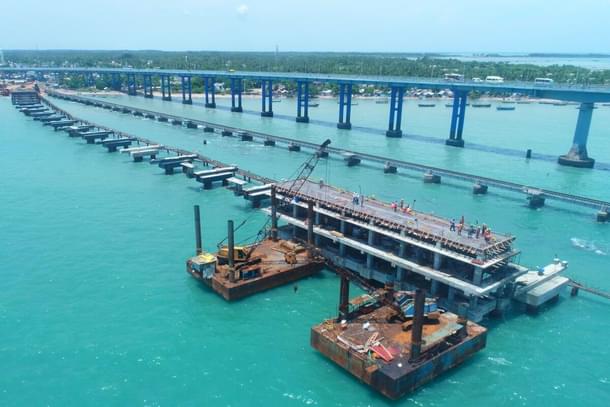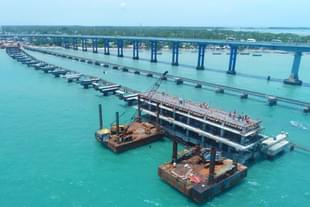News Brief
India's First Vertical Lift Sea Bridge At Pamban Faces Safety Concerns, Expert Committee Appointed For Review
V Bhagya Subhashini
Nov 29, 2024, 07:34 PM | Updated 07:36 PM IST
Save & read from anywhere!
Bookmark stories for easy access on any device or the Swarajya app.


India’s first vertical lift sea bridge at Pamban, off the Rameswaram coast, has drawn criticism from the Commissioner of Railway Safety (CRS), A.M. Chowdhary, who flagged "glaring lapses" in its construction.
Despite its state-of-the-art design, the bridge is marred by deficiencies, including track misalignment and corrosion risks, according to Chowdhary’s eight-page inspection report.
The CRS, who inspected the bridge earlier this month, noted several issues with the Rs 280-crore project executed by Rail Vikas Nigam Limited.
Among the concerns raised were non-standard girder designs, inadequate measures to prevent corrosion in a highly corrosive environment, and flaws in the signaling system. These shortcomings have prompted a speed restriction of 50 kmph on the bridge.
“The century-old cantilever bridge it replaces was a marvel despite limited technology. In contrast, the new bridge demonstrates lapses from planning to execution,” Chowdhary stated in his report dated November 26.
The Railway Ministry has formed a five-member committee, including experts from the Research Design and Standards Organisation (RDSO) and IITs, to address the deficiencies. Railway Minister Ashwini Vaishnaw assured that an in-depth safety analysis would be completed within six weeks, reports India Today.
“The bridge, designed with input from international consultants and proof-checked by IIT-Chennai and IIT-Bombay, incorporates modern corrosion protection methods, but the concerns raised by the CRS will be fully addressed,” Vaishnaw said.
Special painting schemes, stainless steel reinforcements, and advanced welding techniques have been implemented to counter corrosion, but the CRS report highlighted that some components have already begun to deteriorate.
The 2.05-km-long bridge, featuring a 72.5-meter vertical lift span, will allow large ships to pass through, improving connectivity to Rameswaram Island. Construction began in 2020 but faced delays due to the COVID-19 pandemic and technical challenges.
Once operational, the new bridge is expected to accommodate higher-speed trains and boost traffic between the mainland and Rameswaram. It replaces the iconic cantilever bridge built in 1913, which was decommissioned in December 2022 after cracks were discovered.
The Railway Ministry emphasised that the bridge reflects advanced design and construction practices, incorporating innovations like fully welded box sections and fiber-reinforced polymer pathways. However, safety remains a critical focus, with the CRS recommending comprehensive retraining for bridge operators and technicians.
V Bhagya Subhashini is a staff writer at Swarajya. She tracks infrastructure developments.




